The Electrophoretic Deposition of Nanopowders Based on Yttrium Oxide for Bulk Ceramics Fabrication
Abstract
:1. Introduction
2. Results
- Methodology and Sequence of the Experiment to Obtain YLO Compacts.
- Initial suspensions of YLO powder were prepared, they were ultrasonicated and deaggregated, YLO suspension in isopropyl alcohol is named YLO_i_1, YLO suspension in isopropyl alcohol with the addition of acetylacetone is named YLO_iA_1.
- Right after the deaggregation, EPD was carried out from YLO_i_1 and YLO_iA_1 suspensions in two variants of the deposition cell—with either vertical or horizontal EPD.
- Aging of the original suspension YLO_iA_1 for 2 months was made. The suspension was named YLO_iA_2. A vertical EPD was carried out from the YLO_iA_2 suspension and the remained suspension was named YLO_iA_3.
- The EPD was carried out from YLO_iA_3 suspension.
3. Materials and Methods
3.1. Nanopowders and Suspensions
3.2. Suspension Characterization Methods and EPD
4. Conclusions
Author Contributions
Funding
Institutional Review Board Statement
Informed Consent Statement
Data Availability Statement
Acknowledgments
Conflicts of Interest
References
- Picelli, F.; Biasini, V.; Hostaša, J.; Piancastelli, A.; Esposito, L. A useful approach to understand the origin of defects in transparent YAG ceramics. MRS Commun. 2022, in press. [Google Scholar] [CrossRef]
- Krell, A.; Hutzler, T.; Klimke, J. Transmission physics and consequences for materials selection, manufacturing, and applications. J. Eur. Ceram. Soc. 2009, 29, 207–221. [Google Scholar] [CrossRef]
- Lu, J.; Ueda, K.-I.; Yagi, H.; Yanagitani, T.; Akiyama, Y.; Kaminskii, A.A. Neodymium doped yttrium aluminum garnet (Y3Al5O12) nanocrystalline ceramics—A new generation of solid state laser and optical materials. J. Alloy Compd. 2002, 341, 220–225. [Google Scholar] [CrossRef]
- Boltachev, G.; Ivanov, M. Effect of nanoparticle concentration on coagulation rate of colloidal suspensions. Heliyon 2020, 6, e03295. [Google Scholar] [CrossRef]
- Kalinina, E.G.; Pikalova, E.Y. New trends in the development of electrophoretic deposition method in the solid oxide fuel cell technology: Theoretical approaches, experimental solutions and development prospects. Russ. Chem. Rev. 2019, 88, 1179–1219. [Google Scholar] [CrossRef]
- Besra, L.; Liu, M. A review on fundamentals and applications of electrophoretic deposition (EPD). Prog. Mater. Sci. 2007, 52, 1–61. [Google Scholar] [CrossRef]
- Aznam, I.; Mah, J.C.W.; Muchtar, A.; Samalu, M.R.; Ghazali, M.J. A review of key parameters for effective electrophoretic deposition in the fabrication of solid oxide fuel cells. J. Zhejiang Univ. Sci. A 2018, 19, 811–823. [Google Scholar] [CrossRef]
- Pikalova, E.Y.; Kalinina, E.G. Electrophoretic deposition in the solid oxide fuel cell technology: Fundamentals and recent advances. Renew. Sustain. Energy Rev. 2019, 116, 109440. [Google Scholar] [CrossRef]
- Pikalova, E.; Osinkin, D.; Kalinina, E. Direct Electrophoretic Deposition and Characterization of Thin-film Membranes Based on Doped BaCeO3 and CeO2 for Anode-supported Solid Oxide Fuel Cells. Membranes 2022, 12, 682. [Google Scholar] [CrossRef]
- Van der Biest, O.; Vandeperre, L.J. Electrophoretic deposition of materials. Annu. Rev. Mater. Sci. 1999, 29, 327–352. [Google Scholar] [CrossRef]
- Kalinina, E.G.; Samatov, O.M.; Safronov, A.P. Stable suspensions of doped ceria nanopowders for electrophoretic deposition of coatings for solid oxide fuel cells. Inorg. Mater. 2016, 52, 858–864. [Google Scholar] [CrossRef]
- Kalinina, E.G.; Efimov, A.A.; Safronov, A.P. The influence of nanoparticle aggregation on formation of ZrO2 electrolyte thin films by electrophoretic deposition. Thin Solid Film. 2016, 612, 66. [Google Scholar] [CrossRef]
- Dukhin, S.S.; Derjaguin, B.V. Surface and Colloid Sciences; Matijevich, E., Ed.; Wiley-Interscience: New York, NY, USA, 1974; Volume 7, p. 335. [Google Scholar]
- Bredol, M.; Micior, J.; Klemme, S. Electrophoretic deposition of alumina, yttria, yttrium aluminium garnet and lutetium aluminium garnet. J. Mater. Sci. 2014, 49, 6975–6985. [Google Scholar] [CrossRef]
- Gal-Or, L.; Brandon, D.; Goldner, R.; Adi, M.; Cherniak, L.; Perlin, L.; Sezin, N.; Liubovich, S. Method of Electrophoretic Deposition of Laminated Green Bodies. U.S. Patent 5919347 A, 6 July 1999. [Google Scholar]
- Brandon, D.; Cherniak, L. Wear and Thermal Resistant Material Produced from Super Hard Particles Bound in a Matrix of Glassceramic Electrophoretic Deposition. U.S. Patent 7037418 B2, 2 May 2006. [Google Scholar]
- Ivanov, M.; Kalinina, E.; Kopylov, Y.; Kravchenko, V.; Krutikova, I.; Kynast, U.; Li, J.; Leznina, M.; Medvedev, A. Highly transparent Yb-doped (LaxY1−x)2O3 ceramics prepared through colloidal methods of nanoparticles compaction. J. Eur. Ceram. Soc. 2016, 36, 4251–4259. [Google Scholar] [CrossRef]
- Ivanov, M.; Kopylov, Y.; Kravchenko, V.; Zayats, S. Sintering and optical quality of highly transparent Yb doped yttrium lanthanum oxide ceramics. Phys. Status Solidi C 2013, 10, 940–944. [Google Scholar] [CrossRef]
- Ivanov, M.; Kopylov, Y.; Kravchenko, V.; Li, J.; Pan, Y.; Kynast, U.; Lezhnina, M.; Strek, W.; Marciniak, L.; Palashov, O.; et al. Optical, luminescent and laser properties of highly transparent ytterbium doped yttrium lanthanum oxide ceramics. Opt. Mater. 2015, 50, 15–20. [Google Scholar] [CrossRef]
- Li, S.; Zhu, X.; Li, J.; Yavetskiy, R.; Ivanov, M.; Liu, B.; Liu, W.; Pan, Y. Fabrication of 5 at.%Yb: (La0.1Y0.9) 2O3 transparent ceramics by chemical precipitation and vacuum sintering. Opt. Mater. 2017, 71, 56–61. [Google Scholar] [CrossRef]
- Ivanov, M.; Kynast, U.; Leznina, M. Eu3+ doped yttrium oxide nano-luminophores from laser synthesis. J. Lumin. 2016, 169, 744–748. [Google Scholar] [CrossRef]
- Ivanov, M.G.; Krutikova, I.V.; Kynast, U.; Lezhnina, M.; Puzyrev, I.S. Laser-synthesized Y2O3: Eu3+ nanophosphors and their stabilization in water suspensions. Opt. Mater. 2017, 74, 67–75. [Google Scholar] [CrossRef]
- Krutikova, I.V.; Ivanov, M.G.; Murzakaev, A.; Nefedova, K. Laser-synthesized Ce3+ and Pr3+ doped Y2O3 nanoparticles and their characteristics. Mater. Lett. 2020, 265, 127435. [Google Scholar] [CrossRef]
- Peyre, V.; Spalla, O.; Belloni, L.; Nabavi, M. Stability of a Nanometric Zirconia Colloidal Dispersion under Compression: Effect of Surface Complexation by Acetylacetone. J. Colloid Interface Sci. 1997, 187, 184–200. [Google Scholar] [CrossRef]
- Bhattacharjee, S. DLS and zeta potential—What they are and what they are not? J. Control. Release 2016, 235, 337. [Google Scholar] [CrossRef]
- Kalinina, E.G.; Pikalova, E.Y.; Menshikova, A.V.; Nikolaenko, I.V. Electrophoretic deposition of a self-stabilizing suspension based on a nanosized multi-component electrolyte powder prepared by the laser evaporation method. Solid State Ion. 2016, 288, 110–114. [Google Scholar] [CrossRef]
- Kalinina, E.G.; Pikalova, E.Y.; Safronov, A.P. A study of the electrophoretic deposition of thin-film coatings based on barium cerate nanopowder produced by laser evaporation. Russ. J. Appl. Chem. 2017, 90, 701–707. [Google Scholar] [CrossRef]
- Felix, C.; Yaroshchuk, A.; Pasupathi, S.; Pollet, B.G.; Bondarenko, M.P.; Kovalchuk, V.I.; Zholkovskiy, E.K. Electrophoresis and stability of nano-colloids: History, theory and experimental examples. Adv. Colloid Interface Sci. 2014, 211, 77. [Google Scholar] [CrossRef]
- Besra, L.; Uchikoshi, T.; Suzuki, T.S.; Sakka, Y. Experimental verification of pH localization mechanism of particle consolidation at the electrode/solution interface and its application to pulsed DC electrophoretic deposition (EPD). J. Eur. Ceram. Soc. 2010, 30, 1187–1193. [Google Scholar] [CrossRef]
- Mishra, M.; Sakka, Y.; Uchikoshi, T.; Besra, L. pH localization: A case study during electrophoretic deposition of ternary max phase carbide-Ti3SiC2. J. Ceram. Soc. Jpn. 2013, 121, 348–354. [Google Scholar] [CrossRef] [Green Version]
- Kotov, Y.A.; Samatov, O.M.; Ivanov, M.G.; Murzakaev, A.M.; Medvedev, A.I.; Timoshenkova, O.R.; Demina, T.M.; V’yukhina, I.V. Production and characteristics of composite nanopowders using a fiber ytterbium laser. Tech. Phys. 2011, 56, 652–655. [Google Scholar] [CrossRef]
- Viyukhina, I.V.; Ivanov, M.G.; Kalinina, E.G.; Puzyrev, I.S.; Yatluk, Y.G. Electro-kinetics properties of NDY nano-powders in aqueous suspensions with polycarboxylates presence. Perspekt. Mater. 2011, 4, 62–68, ISSN:1028-978X. [Google Scholar]
- Puzyrev, I.S.; Ivanov, M.G.; Krutikova, I.V. Physicochemical properties of Al2O3 and Y2O3 nanopowders produced by laser synthesis and their aqueous dispersions, Russian Chemical Bulletin, International Edition (Published in Russian in Izvestiya Akademii Nauk. Seriya Khimicheskaya). Russ. Chem. Bull. 2014, 63, 1504–1510. [Google Scholar] [CrossRef]
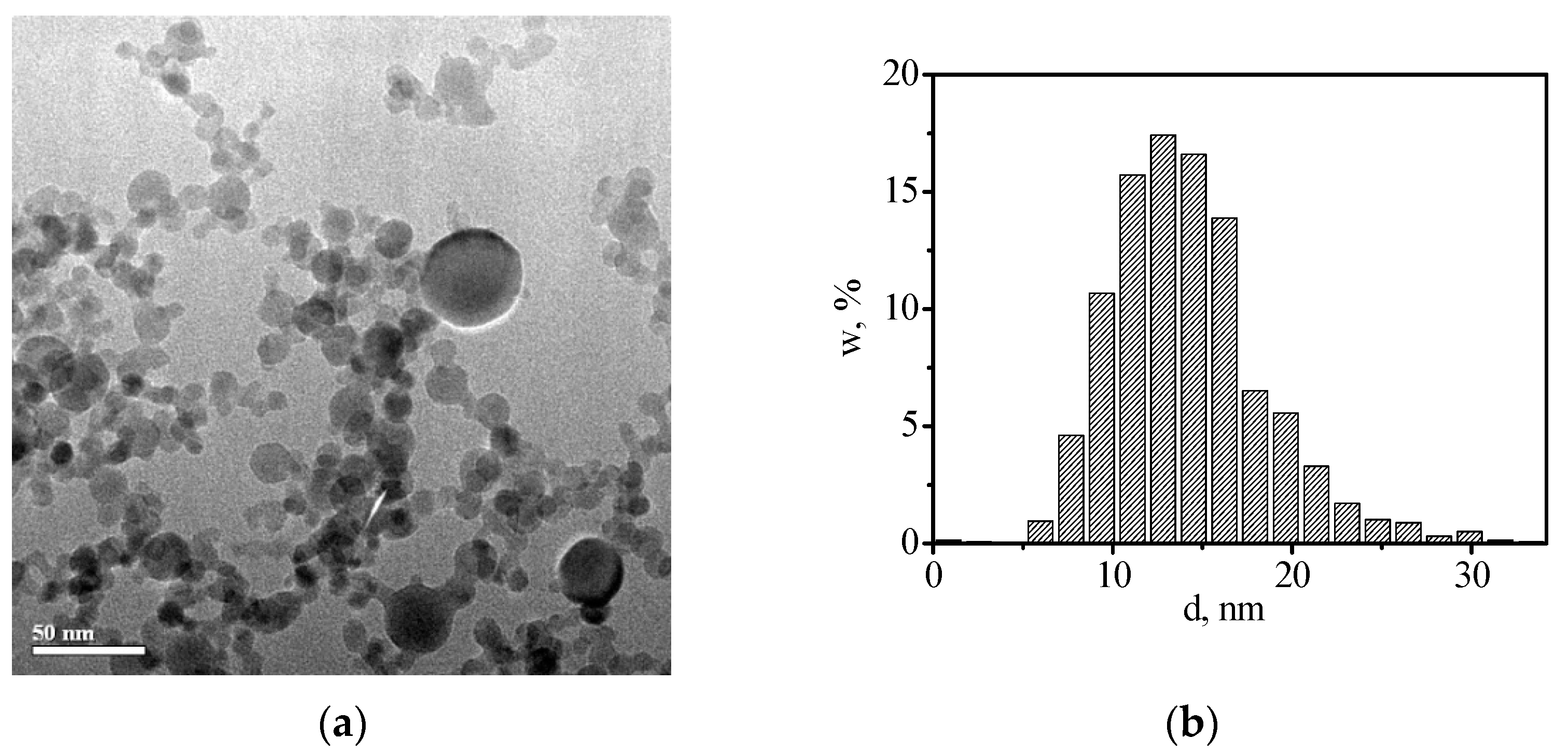
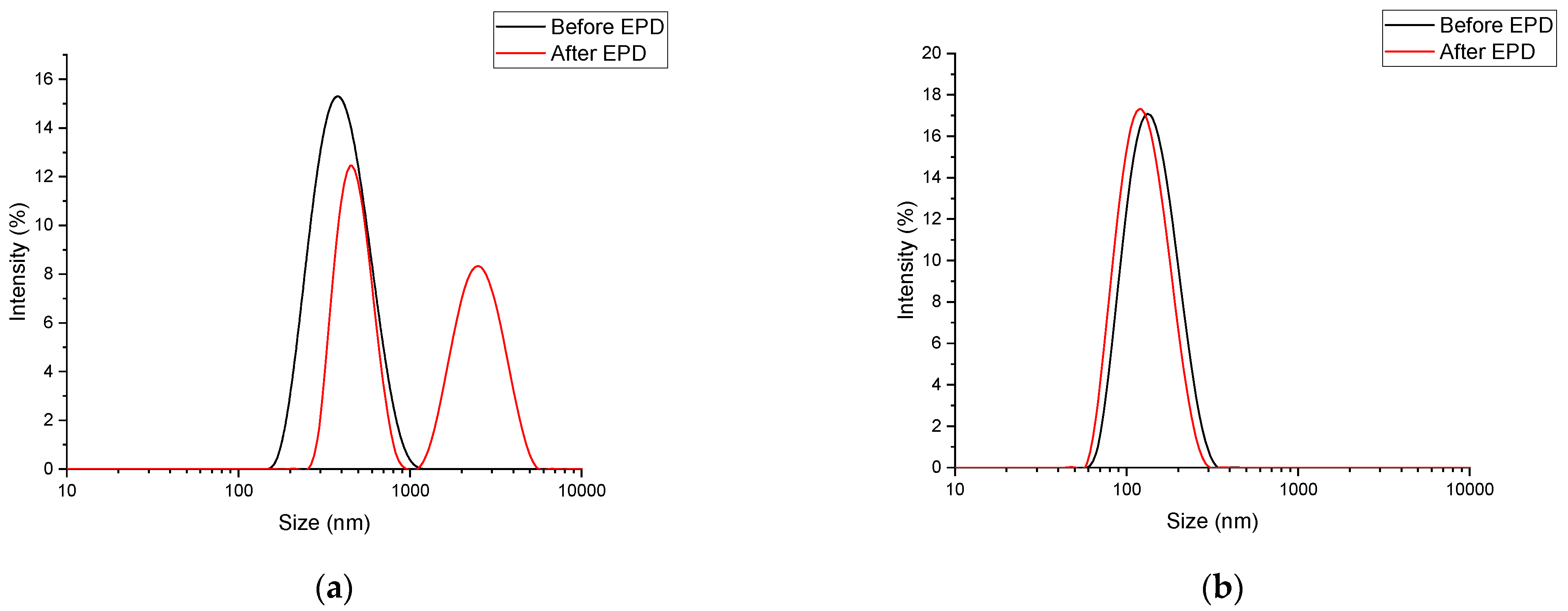


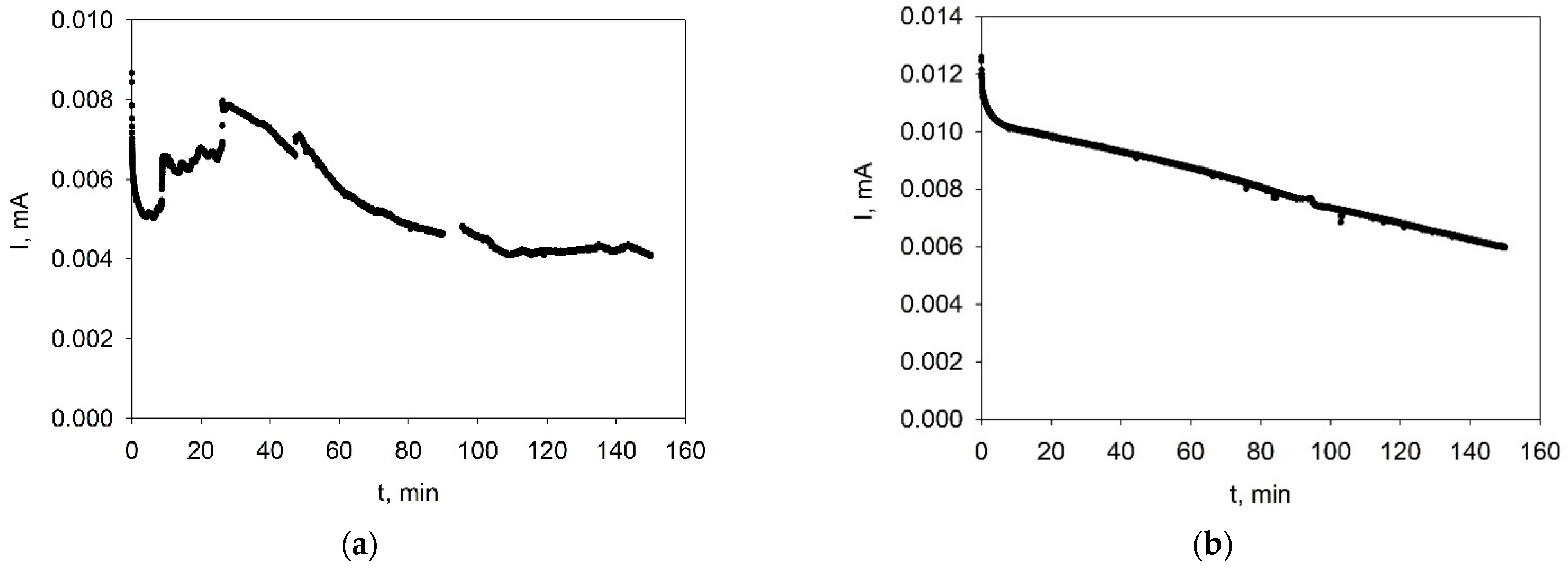
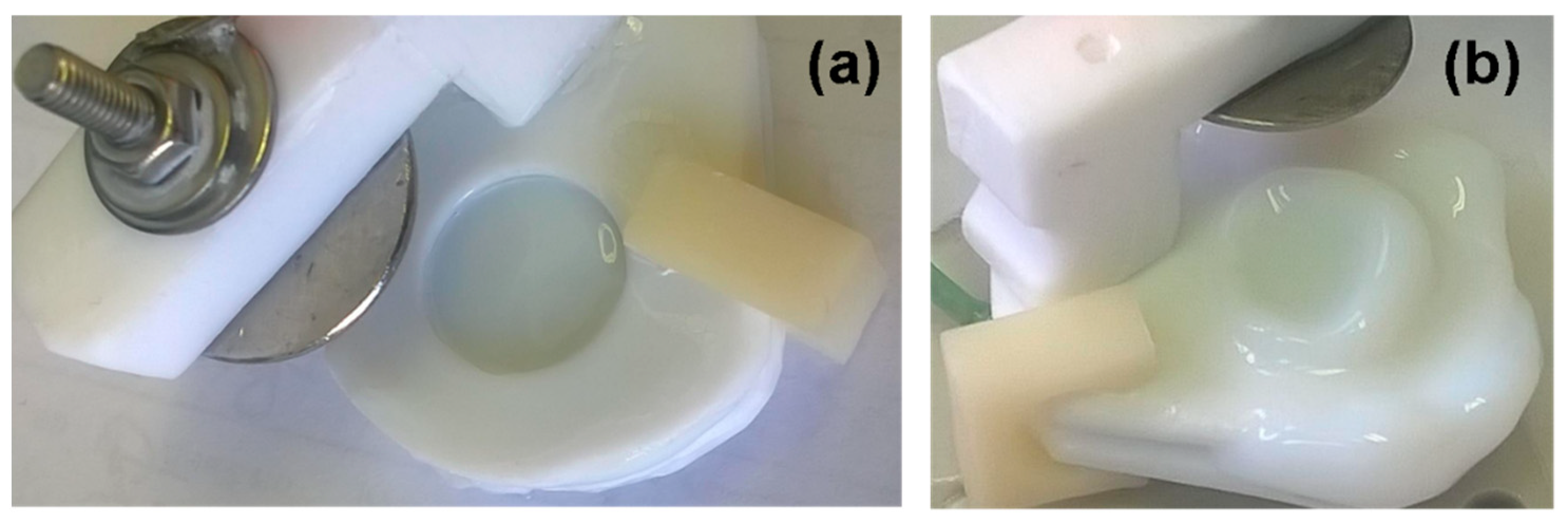
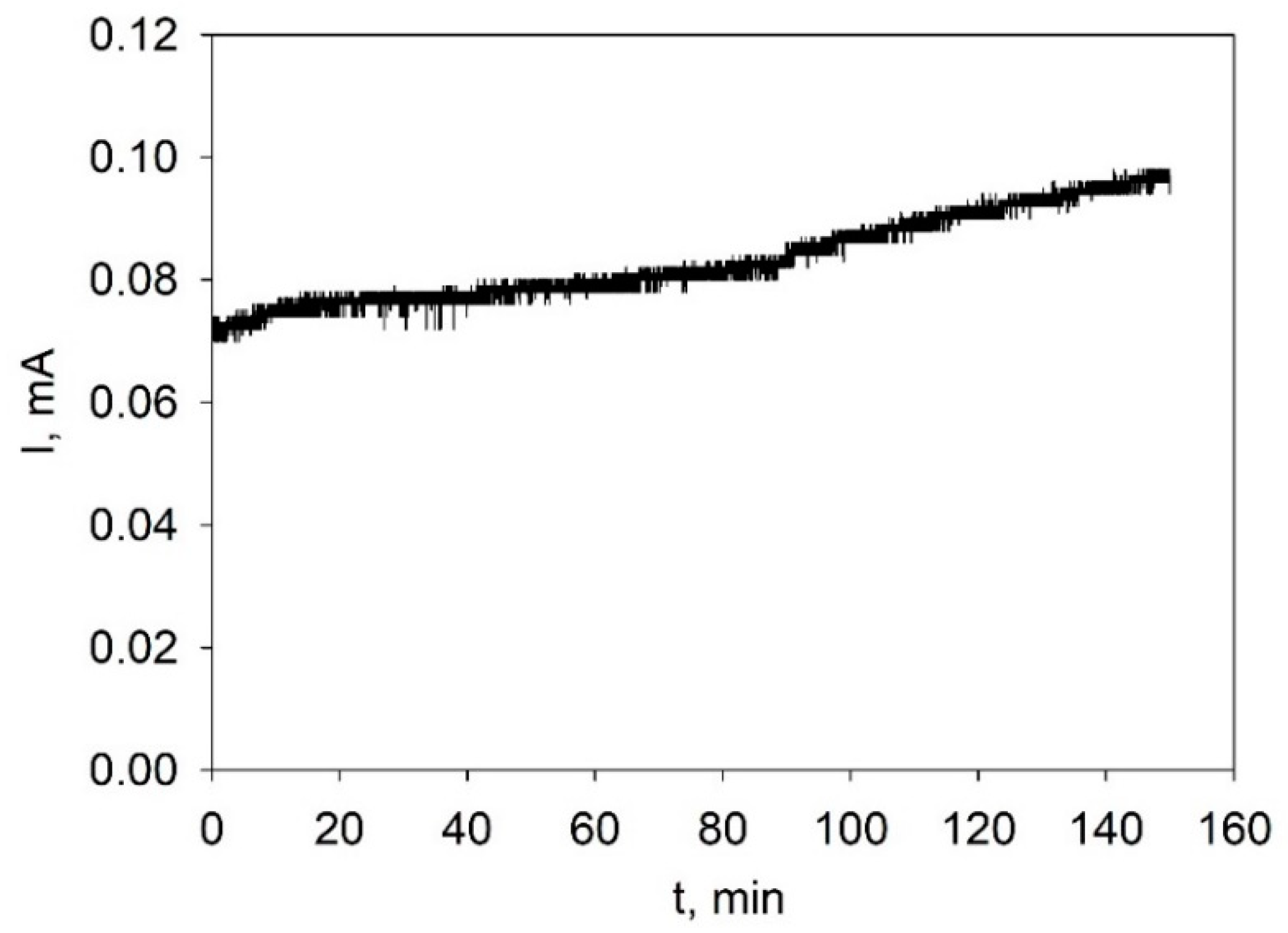
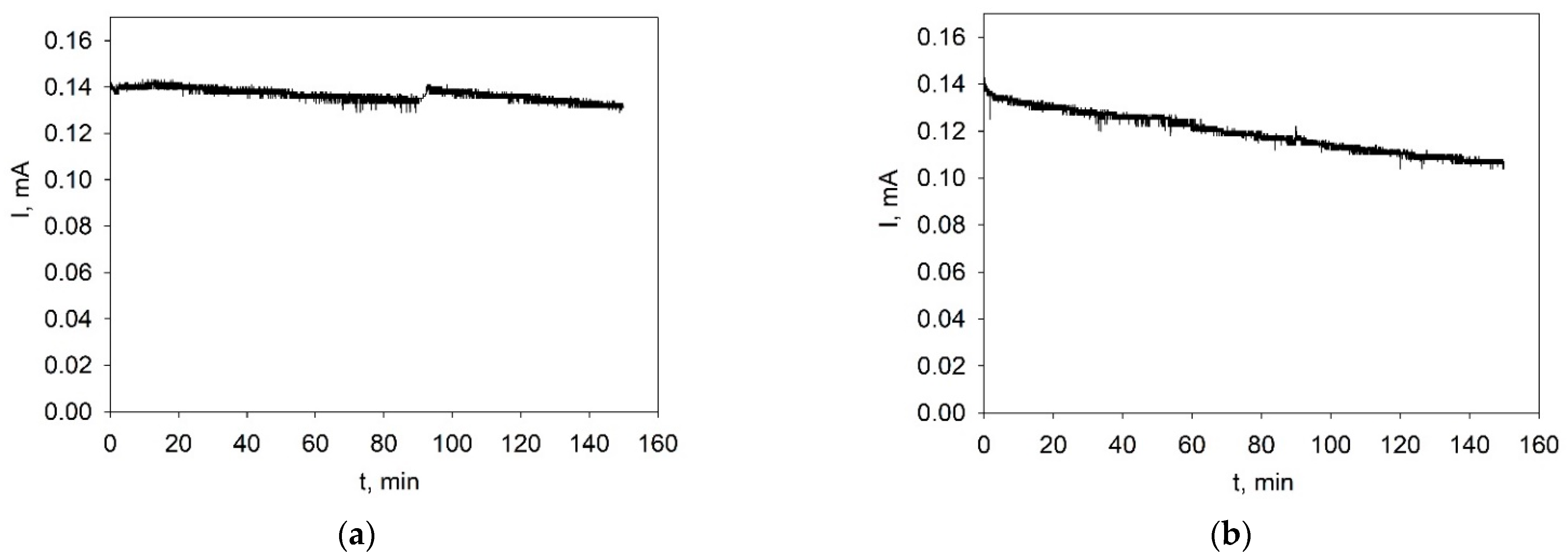

| No. | Suspension | Medium | pH | ζ-Potential, mV | EPD Direction | Average Current, mA | Weight Energy Consumption | ||
|---|---|---|---|---|---|---|---|---|---|
| Before EPD | After EPD | Before EPD | After EPD | ||||||
| 1 | YLO_i_1 | iPrOH | 7.8 | 6.9 | +24 | +28 | Vertical | 0.005 | 91.4 mg 2031 mg/C |
| 2 | YLO_i_1 | iPrOH | 7.8 | 6.7 | +24 | +27 | Horizontal | 0.008 | 188.6 mg 2619 mg/C |
| 3 | YLO_iA_1 | iPrOH_Hacac | 7.9 | 6.7 | +83 | +104 | Vertical | 0.08 | 395 mg 549 mg/C |
| 4 | YLO_iA_2 | iPrOH_Hacac | 6.0 | 5.9 | +50 | +49 | Vertical | 0.136 | 402.3 mg 326 mg/C |
| 5 | YLO_iA_3 | iPrOH_Hacac | 5.9 | 5.9 | +39 | +39 | Vertical | 0.119 | 329.8 mg 307 mg/C |
| Suspension | EPD Direction and Time (min) | Thickness, mm | Density, % of Theoretical |
|---|---|---|---|
| YLO_i_1 | Vertical, 150 | 2 | 12 |
| YLO_i_1 | Horizontal, 150 | 4 | 17 |
| YLO_iA_1 | Vertical, 150 | 3.2 | 30 |
| YLO_iA_1 | Vertical, 90 | 2.4 | 37 |
| YLO_iA_2 aged | Vertical, 150 | 3 | 29 |
| YLO_iA_3 repeated EPD from YLO_iA_2 | Vertical, 150 | 3.5 | 25 |
Publisher’s Note: MDPI stays neutral with regard to jurisdictional claims in published maps and institutional affiliations. |
© 2022 by the authors. Licensee MDPI, Basel, Switzerland. This article is an open access article distributed under the terms and conditions of the Creative Commons Attribution (CC BY) license (https://creativecommons.org/licenses/by/4.0/).
Share and Cite
Kalinina, E.; Ivanov, M. The Electrophoretic Deposition of Nanopowders Based on Yttrium Oxide for Bulk Ceramics Fabrication. Inorganics 2022, 10, 243. https://doi.org/10.3390/inorganics10120243
Kalinina E, Ivanov M. The Electrophoretic Deposition of Nanopowders Based on Yttrium Oxide for Bulk Ceramics Fabrication. Inorganics. 2022; 10(12):243. https://doi.org/10.3390/inorganics10120243
Chicago/Turabian StyleKalinina, Elena, and Maxim Ivanov. 2022. "The Electrophoretic Deposition of Nanopowders Based on Yttrium Oxide for Bulk Ceramics Fabrication" Inorganics 10, no. 12: 243. https://doi.org/10.3390/inorganics10120243






